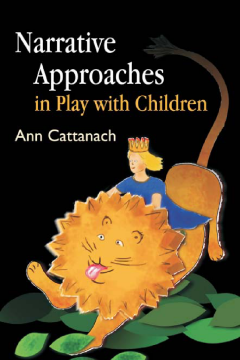
Additional Information
Book Details
Abstract
Narrative play is a way of communicating with children using imaginative stories and narratives to share and make sense of life events. This book describes using narrative play therapeutically with children who have lived in multiple families, children who have problems with social understanding and children who have learning difficulties.
Ann Cattanach explains how children's stories and narratives, whether they are about real or imagined events, can be interpreted as indicators of their experiences, their ideas, and a dimension of who they are. She demonstrates this with examples of children's stories from her clinical experience, and provides narrative play techniques and sample scripts both for therapists and for parents whose circumstances require a therapeutic parenting approach.
This book is essential reading for play therapists, social workers and other professionals working with children, as well as parents and carers of children who are experiencing social and/or learning difficulties.
What a joy it was to read this book - so different from the usual run-of-the-mill therapy books directed at practitioners working with children. This text reiterates what every parent and child therapist knows, namely, that all children love a good story. The impact of good story should never be underestimated, children learn about themselves from the stories other people tell them, and from stories they make up about themselves.
Counselling Children and Young People
Overall, it is a straightforward book to read and take ideas from. I think this book will be very useful for hard-pressed child care practitioners wanting t o increase their skills and knowledge to engage in direct work with children.
Research Policy and Planning
Ann Cattanach is a play therapist and dramatherapist in private practice in Scotland. She has wide experience of teaching and lecturing in drama, dramatherapy and speech communication, and has also worked as a child psychotherapist, family therapist and dramatherapist for Social Services and NHS Trusts. She has written many books including Process in the Arts Therapies, Play Therapy: Where the Sky Meets the Underworld and Play Therapy with Abused Children, all published by Jessica Kingsley Publishers.
Each chapter is written from Cattanach's wide personal experience of working with children with learning difficulties, with problems in social understanding and who have lived in multiple families. Her experiences are backed up explanations of the types of play suitable to be used with children of different ages, suggestions for appropriate toys and materials, how to structure a play environment and an offering of a number of specific stories (the majority of which are of Scottish origin) suitable for a variety of situations.
Naplic, 2007
Ann Cattanach is an experienced therapist and writer who brings depth of knowledge and understanding to her writing... Cattanach articulates an impressive depth and range of stories from different epochs and cultures which are a treasure trove for the practitioner...Subsequent chapters are jam-packed with rhymes and stories on the themes of her chapter topics, she uses case vignettes to highlight the themes and the narrative material... I...think students of psychotherapy will probably find it useful and interesting.
The Psychotherapist, Christine Lister-Ford, Integrative Psychotherapist, UKPC Registrant, UKPC Honorary Fellow
Table of Contents
| Section Title | Page | Action | Price |
|---|---|---|---|
| Part 1: Introduction | |||
| Chapter 1: trends influencing gender equality and women’s economic empowerment practice | |||
| Chapter 2: concepts and terms | |||
| Part 2: Key approaches for women’s economic empowerment | |||
| Chapter 3: regulatory and socio-cultural enabling environments | |||
| Chapter 4: sector development—focus on agriculture | |||
| Chapter five: financial inclusion—challenges and opportunities | |||
| Chapter 6: gender lens investing for business growth and impact | |||
| Chapter 7: enterprise development—starting and building businesses | |||
| Chapter 8: labour force participation—a pathway to greater equality | |||
| Chapter 9: information and communication technology for WEE | |||
| Part 3: Managing risk and assessing outcomes | |||
| Chapter 10: managing risks for women’s participation | |||
| Chapter 11: measuring women’s economic empowerment | |||
| Part 4: In conclusion | |||
| Chapter 12: emerging trends in innovative finance and technology innovation |
